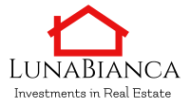Rate of Return, Yield
Usually, yield is only based on rental income, whereas a total rate return includes capital gains. If you are trying to make a decision to buy or not a property both measurements are important
Yield is similar to CAP RATE cap rate and is basically the yield of a property over a one-year time assuming the property is purchased on cash.
However, the total rate of return of a Real Estate property has 2 components – One generated by the rental income, the other by the increase ( or decrease ) in value of the property
First, we need to calculate the NOI or Net Operating Income
Total Rate of Return = ( NOI + Capital Gain ) / (initial price )
= NOI / (Initial Price) + Capital Gain / ( Initial Price )
= Rent Yield + Capital Gain Yield
Example:
The Beginning of the period property value is $500,000
The property brings a NOI of $65,000 which gives us a gain of
Rent Yield = $65000/$500,000 = 13%
Also the property value at the end of the period is $550,000
That gives a Rental yield of $50,000 / $500,000 = 10%
Total Rate of Return = ( $65,000 + [$550,000 – $500,000]) / $500,000 = 23% Prices
One More Example
According to Zillow last year Residential Real Estate Value in the United States have gone up 16.7% over the past year and Zillow predicts prices will rise 12.1% in the next year (2021 – 2022)
Real Estate Value in the long run in the US grows by an average 3.5% per year
Now it is up to you to choose a value for Capital Gain either 12.1% or 3.5% – I will rather be conservative so I will use 3.5%
So if we do not have a better estimate of the future value we can calculate it this way
Total Return = NOI / Cost + 3.5%
Returns from Real Estate vs Stock Market returns
The average return of the S&P 500 has been around a pretty healthy 10% per year in the past 20 years. How does that compare with the returns of real estate? Well if you buy a property and you do not rent it out you can expect a return of 3.5% minus holding which will not leave you much. However, if you manage to rent out the property for a 6.5% CAP rate since you can expect also a 3.5% average appreciation the two returns are comparable. Therefore it is always better to have an investment in both since diversification lowers the risk
Comment
While it is true that Total Yeld = Rent Yield + Capital Gain Yield
The investor does not see the Capital Gain Yield until he/she sells the property. That does not happen your cash flow. There is however one more item that cannot be considered officially an income but helps your cash flow: Depreciation
Depreciation is a deduction that reduces the investor’s taxable income.
Any residential investment property will depreciate for 27.5 years, any commercial property for 39 years. This equates to a 3.636 percent deduction from your income tax of the cost base each year for residential. This will allow keeping in your pocket ( at least for a while ) 3.636% of the value of the structure on your property ( land does not get depreciated). Depreciation will continue for up to 27.5 (or 39) years or until you sell the property, whichever comes first.
- Resources - February 29, 2024
- Funding Resourses for Real Estate - February 28, 2024
- Off Market Maryland properties - February 28, 2024

